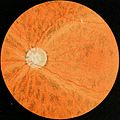 Kentucky: In a new University of Kentucky study
published yesterday in Cell Reports, a leading scientific journal in
cell biology, researchers describe a new molecular mechanism that
contributes to age-related macular degeneration (AMD) due to
accumulation of excessive iron within the cells of the retina. Cells
of the body use iron in dozens of normal metabolic processes. However,
excessive iron or "iron overload" can be very damaging to cells and
tissues and is implicated in numerous diseases, including AMD.
Kentucky: In a new University of Kentucky study
published yesterday in Cell Reports, a leading scientific journal in
cell biology, researchers describe a new molecular mechanism that
contributes to age-related macular degeneration (AMD) due to
accumulation of excessive iron within the cells of the retina. Cells
of the body use iron in dozens of normal metabolic processes. However,
excessive iron or "iron overload" can be very damaging to cells and
tissues and is implicated in numerous diseases, including AMD. "The reason that cells die due to iron overload is not fully understood," said Bradley Gelfand, assistant professor in the Department of Ophthalmology and Visual Sciences at the UK College of Medicine and lead author on the study. "Our study found that iron overload induces retinal cell death by activating an inflammatory signaling pathway called the inflammasome. This occurs because iron specifically impairs the ability of retinal cells to process inflammatory RNAs called Alu RNAs. In the presence of iron overload, these RNAs build up and cause inflammasome-mediated cell death."
Iron overload is most commonly associated with diseases like thalassemia and hemochromatosis. The liver is the most commonly associated target of iron overload. These diseases are due to systemic (i.e. whole body) overload of iron. Other diseases such as AMD, Parkinson's and Alzheimer's are associated with 'local' iron overload in which excess iron has been measured specifically in the area of release.
Implications for the study are that treatments previously targeted specifically to prevent inflammatory processes in AMD, may also prevent toxicity due to iron overload which is also thought to contribute to disease, but was previously thought to be separate.
This study was funded by the NIH and the International Retinal Research Foundation.